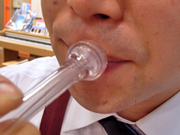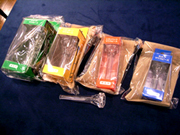How to Play the Tuba
Helpful Items When Practicing
Check your embouchure with a practice rim
When first starting out with brass instruments, students practice "buzzing" by making a lip trill without using any instrument at all. This gives a sense of the technique needed to produce notes. A practice rim is an effective tool for learning buzzing. If you hold the rim against your lips and buzz in front of a mirror, you can see how the mouthpiece should touch your lips and what shape your lips should make. Practicing your lip shape and movement while looking in the mirror allows you to pay attention to your embouchure without worrying about the sound. Moreover, even very competent players can develop undesirable habits and imperfect embouchure, so they can also benefit from using a rim from time to time.

Practice rims
A practice mouthpiece that you can take with you anywhere
Apparently, there are many brass instrument musicians who carry their mouthpieces around to help them practice. Even at home, this can be an effective practice technique. Please note, however, that the mouthpiece is very delicate and cannot stand up to much abuse. Considering the risks of dropping or damaging it, you probably want to avoid carrying it around unprotected. This is where it can be handy to have a clear plastic mouthpiece used only for practice. They are light and durable, but inexpensive and good for practicing anytime you are out and about. Most importantly, they are transparent. You can look in the mirror and check the shape of your lips as you practice. Also, if a teacher or classmate is teaching you the embouchure technique, a normal mouthpiece would obscure their lips, while a transparent practice mouthpiece will reveal areas you normally could not see.

A plastic mouthpiece for practice use

A mouthpiece for practice use

A practice mouthpiece. There are models available for the trumpet, trombone, horn, and tuba.
Musical Instrument Guide:Tuba Contents
Origins
Structure
How to Play
How the Instrument is Made
Choosing an Instrument
Trivia
- A Massive Tuba from 100 Years Ago
- Depending on the Country, a Baritone is Not a Baritone
- The Cinbasso-Popular in Italian Opera
- All Brass Instruments Have Marching Band Models
- Famous Musical Pieces for the Tuba (Bass)
- The Compensating System for the Euphonium
- There are Various Mutes for the Tuba
- Ease of Playing Pedal Tones
- Why Are Tubas So Expensive?
- Do Jazz Musicians Play the Tuba?
- Brass Band Songs Featuring the Tuba
- An Instrument in the Key of B♭, Yet the Music is Written in C
